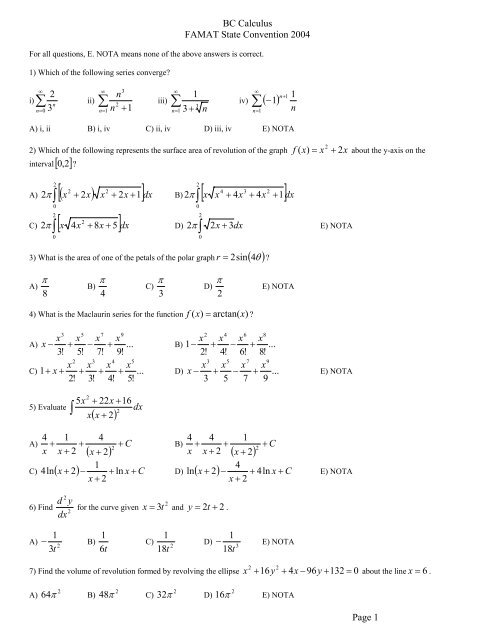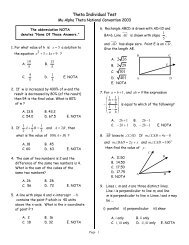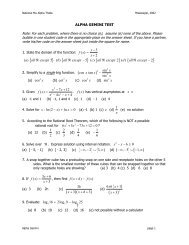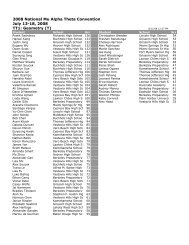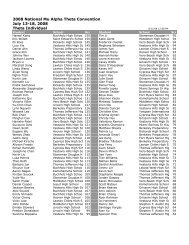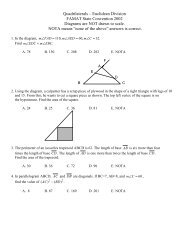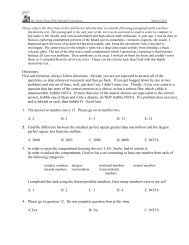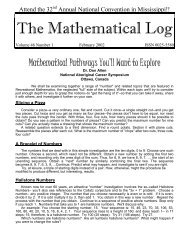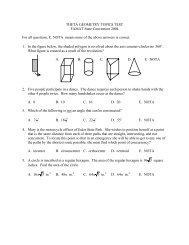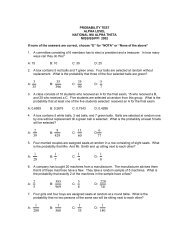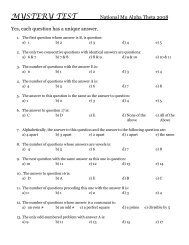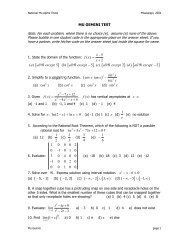x - Mu Alpha Theta
x - Mu Alpha Theta
x - Mu Alpha Theta
Create successful ePaper yourself
Turn your PDF publications into a flip-book with our unique Google optimized e-Paper software.
BC Calculus<br />
FAMAT State Convention 2004<br />
For all questions, E. NOTA means none of the above answers is correct.<br />
1) Which of the following series converge?<br />
∞<br />
∞ 3<br />
2<br />
n<br />
i) ∑ ii)<br />
n ∑ iii)<br />
2<br />
n 1<br />
n=0 3<br />
n= 1 +<br />
∑ ∞ 1<br />
3<br />
= 3+<br />
n 1<br />
n<br />
∞<br />
∑<br />
iv) ( −1)<br />
n=<br />
1<br />
n+<br />
1 1<br />
n<br />
A) i, ii B) i, iv C) ii, iv D) iii, iv E) NOTA<br />
2) Which of the following represents the surface area of revolution of the graph f ( x)<br />
= x<br />
2 + 2x<br />
about the y-axis on the<br />
interval[ 0,2]?<br />
2<br />
[ x + 2x<br />
1]<br />
2<br />
2<br />
A) π ( x + x)<br />
4 3 2<br />
2 ∫ 2 + dx B) 2π ∫ [ x x + 4x<br />
+ 4x<br />
+ 1]dx<br />
0<br />
0<br />
2<br />
2<br />
2<br />
C) 2π ∫ [ x 4x<br />
+ 8x<br />
+ 5] dx<br />
D) 2π ∫ 2x + 3dx<br />
E) NOTA<br />
0<br />
3) What is the area of one of the petals of the polar graph = 2sin( 4θ )<br />
2<br />
0<br />
r ?<br />
A) 8<br />
π<br />
B) 4<br />
π<br />
C) 3<br />
π<br />
D) 2<br />
π<br />
E) NOTA<br />
4) What is the Maclaurin series for the function f ( x)<br />
= arctan( x)<br />
?<br />
3 5 7 9<br />
2 4 6 8<br />
x x x x<br />
x x x x<br />
A) x − + − + ...<br />
B) 1 − + − + ...<br />
3! 5! 7! 9!<br />
2! 4! 6! 8!<br />
2 3 4 5<br />
3 5 7 9<br />
x x x x<br />
x x x x<br />
C) 1 + x + + + + ... D) x − + − + ...<br />
E) NOTA<br />
2! 3! 4! 5!<br />
3 5 7 9<br />
5) Evaluate<br />
2<br />
5x<br />
+ 22x<br />
+ 16<br />
∫ dx<br />
2<br />
x +<br />
( x 2)<br />
A)<br />
4<br />
x<br />
1 4<br />
+ + C<br />
x + 2 ( x + 2)<br />
1<br />
+ ln<br />
x + 2<br />
+<br />
2<br />
4 4 1<br />
B) + + + C<br />
2<br />
x x + 2 ( x + 2)<br />
4<br />
ln + 2 4ln<br />
E) NOTA<br />
x + 2<br />
C) 4 ln( x 2) − + x + C D) ( x ) − + x + C<br />
6) Find<br />
2<br />
d y<br />
2<br />
dx<br />
for the curve given<br />
2<br />
x = 3t and y = 2 t + 2 .<br />
A)<br />
1<br />
− B)<br />
2<br />
3t<br />
1<br />
6t<br />
C)<br />
1<br />
18t<br />
2<br />
D)<br />
1<br />
− E) NOTA<br />
3<br />
18t<br />
7) Find the volume of revolution formed by revolving the ellipse x 2 + 16y<br />
2 + 4x<br />
− 96y<br />
+ 132 = 0 about the line x = 6 .<br />
π<br />
2<br />
2<br />
2<br />
2<br />
A) 64 B) 48π C) 32π D) 16π<br />
E) NOTA<br />
Page 1
1 x<br />
8) Evaluate∫ − cos2<br />
dx<br />
2<br />
2<br />
A) − cos x + C B)<br />
sin<br />
( 2x)<br />
+ 2x<br />
+ C<br />
4<br />
BC Calculus<br />
FAMAT State Convention 2004<br />
C)<br />
sin<br />
( 2x)<br />
− 2x<br />
+ C<br />
4<br />
2<br />
D) − sin x + C E) NOTA<br />
9) Find dy where f ( x)<br />
= ( 4sin x) ( arcsin(<br />
4x)<br />
) .<br />
dx<br />
⎛<br />
16sin x<br />
⎞<br />
A) ( 4cos x ) ( arcsin( 4x)<br />
) + ⎜<br />
⎟ B) ( 4cos x ) ( arcsin( 4x)<br />
) + ⎜<br />
2<br />
⎝ 1−16x<br />
⎠<br />
⎟ 2<br />
⎝ 1−16x<br />
⎠<br />
⎛<br />
16sin x<br />
⎞<br />
⎛<br />
4cos x<br />
⎛ 4sin x ⎞<br />
x E) NOTA<br />
C) ( 4sin x ) ( arccos( 4x)<br />
) + ⎜<br />
⎟ D) ( 4cos ) ( arcsin( 4x)<br />
) + ⎜<br />
2<br />
⎝ 1−16x<br />
⎠<br />
⎟ 2<br />
⎝ 1−<br />
4x<br />
⎠<br />
= on the interval ⎛ 3 3 ⎞<br />
⎜ − , ⎟<br />
⎝ 2 2 ?<br />
⎠<br />
A) 20.99 B) 28.20 C) 6.68 D) 5.31 E) NOTA<br />
10) What is the arc length, to the nearest hundredth, of the graph of y −ln( cos x)<br />
⎞<br />
π<br />
dx<br />
11) Evaluate<br />
∫ 2<br />
x − 8x<br />
+ 20<br />
− π<br />
⎛<br />
⎜ln⎜<br />
⎟ + ln⎜<br />
⎟<br />
2 ⎝ ⎝ 2 ⎠ ⎝ 2 ⎠<br />
B)<br />
1<br />
( arctan π + 2 + arctan π − 2) )<br />
4<br />
D)<br />
( ) ( )<br />
A) 1 ⎛ π + 4 ⎞ ⎛ π − 4 ⎞⎞<br />
⎟⎠<br />
C) ( ) (<br />
( π + 4) − ln( π − 4) arctan( π + 4) − arctan( π 4)<br />
ln +<br />
+<br />
2<br />
2<br />
1 ⎛ ⎛ π + 4 ⎞ ⎛ π − 4 ⎞⎞<br />
⎜arctan⎜<br />
⎟ + arctan⎜<br />
⎟⎟<br />
E) NOTA<br />
2 ⎝ ⎝ 2 ⎠ ⎝ 2 ⎠⎠<br />
12) What is the arc length of the polar function r = sinθ<br />
on the interval from<br />
π<br />
θ = to<br />
4<br />
2π<br />
θ = .<br />
3<br />
A)<br />
3 −<br />
2<br />
2<br />
5π<br />
B) 12<br />
C)<br />
2 −1<br />
2<br />
7π<br />
D) 12<br />
E) NOTA<br />
13) Which of the following integrals represents the surface area of revolution of the graph of y = 2x<br />
3 − 6x<br />
about the x-axis on the<br />
closed interval from x = 0 to x = 3 ?<br />
3<br />
3<br />
3<br />
2 B) π ( 2 − 6x)<br />
4 2<br />
A) π ∫ [ x 36x<br />
− 72x<br />
+ 37]dx<br />
0<br />
[ ]dx<br />
∫<br />
0<br />
4 2<br />
[ x 36x<br />
− 72x<br />
+ 37]dx<br />
3<br />
3<br />
2 2<br />
2 2<br />
C) 2π ∫ 12x( x − 3)( x −1)<br />
D)<br />
∫ [ 12x( x − 3)( x −1)]dx<br />
0<br />
π E) NOTA<br />
0<br />
14) Which of the following improper integrals converges to a defined value?<br />
∞<br />
∞<br />
∞<br />
−<br />
1<br />
1<br />
A)<br />
∫ xe x dx<br />
B)<br />
∫ dx<br />
C) dx<br />
3<br />
x<br />
x<br />
0<br />
0<br />
∫<br />
D)<br />
∫ cos πx dx<br />
E) NOTA<br />
1<br />
∞<br />
0<br />
( )<br />
Page 2
BC Calculus<br />
FAMAT State Convention 2004<br />
15) A tangent line can be drawn on the polar graph r = 3 − 3cosθ<br />
such that the line is tangent to exactly two distinct points on the<br />
graph. What are the polar coordinates of these two points?<br />
A) ⎛ 9 2 ⎞<br />
,<br />
π ⎛ ⎞<br />
⎜ ⎟ & ⎜<br />
9 4<br />
,<br />
π ⎟ B)<br />
⎛ 3 3 ⎞ ⎛<br />
⎜ ⎟<br />
⎝ 2 3 ⎠ ⎝ 2 3 ⎠ 1 , 3 − &<br />
3 3 ⎞<br />
⎜ + ⎟<br />
⎝ 2 1, 3<br />
⎠ ⎝ 2 ⎠<br />
C) ( 6 , π ) & ( 0 , 0)<br />
D)<br />
⎛ ⎞<br />
⎜<br />
3 ,<br />
π ⎟ & ⎛ 5 ⎞<br />
⎜<br />
3 ,<br />
π ⎟ E) NOTA<br />
⎝ 2 3 ⎠ ⎝ 2 3 ⎠<br />
2<br />
f '( )<br />
( x) 2arcsin( 2x) + 3x<br />
1−<br />
2x<br />
16) Find x of the function f<br />
= .<br />
A)<br />
C)<br />
1<br />
3x<br />
2<br />
2<br />
− 2x<br />
− +<br />
B)<br />
2<br />
2<br />
4<br />
1−<br />
2x<br />
2<br />
1−<br />
2x<br />
+ 3 1−<br />
2x<br />
2<br />
4<br />
1−<br />
4x<br />
2<br />
3x<br />
−<br />
1−<br />
2x<br />
2<br />
D)<br />
4<br />
1−<br />
4x<br />
2<br />
2<br />
1−<br />
4x<br />
2<br />
+ 3<br />
+<br />
1−<br />
2x<br />
1−<br />
2x<br />
2<br />
2<br />
−<br />
−<br />
6x<br />
2<br />
1−<br />
2x<br />
2<br />
3x<br />
1−<br />
2x<br />
2<br />
2<br />
E) NOTA<br />
4 3<br />
17) Evaluate<br />
∫ ( sin φ cos φ)<br />
dφ<br />
5<br />
4<br />
sin φ cos φ<br />
A) + + C<br />
5 4<br />
5<br />
7<br />
sin φ sin φ<br />
B) − + C<br />
5 7<br />
5<br />
7<br />
cos φ cos φ<br />
C) − + C<br />
5 7<br />
5<br />
6<br />
cos φ cos φ<br />
D) + + C<br />
5 6<br />
E) NOTA<br />
18) Evaluate<br />
∫ ( arcsin x + arctan x)<br />
dx<br />
1<br />
2<br />
2<br />
2<br />
A) ( arcsin x + arctan x) + C<br />
2<br />
ln x + 1<br />
2<br />
2 ( )<br />
C) x arctan x + xarcsin<br />
x + 1−<br />
x − + C<br />
x<br />
19) Evaluate lim<br />
x→∞<br />
2e<br />
3<br />
2x<br />
− 2x<br />
2<br />
ln x + 1<br />
2<br />
( )<br />
B) x x + x x + − + C<br />
arctan<br />
arcsin<br />
1−<br />
x<br />
2 ( )<br />
D) x + arcsin x + 1−<br />
x − + C<br />
2<br />
2<br />
ln x + 1<br />
arctan E) NOTA<br />
2<br />
A) 0 B) 1 C) ∞ D) Does Not Exist E) NOTA<br />
( )<br />
n<br />
2 4 6 8<br />
2n<br />
x x x x −1<br />
x<br />
20) 1 − + − + −...<br />
+ + ... is the Maclaurin Series for which of the following?<br />
2! 4! 6! 8! 2n<br />
+ 1<br />
A) y = sin x<br />
B) y = ln x<br />
C)<br />
x<br />
y = tan x<br />
D) y = e<br />
E) NOTA<br />
∞<br />
1<br />
21) Make the following a true statement: The p-series ∑ , with n as a positive integer, ___________.<br />
p<br />
n<br />
n=1<br />
A) converges if p < 0 B) converges if p > 1 C) converges if 0 < p < 1 D) converges if p < 1 E) NOTA<br />
2<br />
22) What is the x-coordinate of the centroid of the region bounded by the functions f ( x)<br />
= 6x<br />
− x and g( x)<br />
= 12 − 2x<br />
?<br />
A)<br />
21<br />
5<br />
B) 3 C)<br />
15<br />
4<br />
D) 4 E) NOTA<br />
Page 3
BC Calculus<br />
FAMAT State Convention 2004<br />
2<br />
23) What is the y-coordinate of the centroid of the region bounded by the functions f ( x)<br />
= 6x<br />
− x and g( x)<br />
= 12 − 2x<br />
?<br />
A)<br />
28<br />
5<br />
B) 4 C)<br />
56<br />
5<br />
71<br />
D) 10<br />
E) NOTA<br />
24) Find the slope and the concavity for the curve given by x = t 3 +1 and<br />
y = t at the point ( 2 ,1)<br />
.<br />
A) 2<br />
3 ; concave up B) 3<br />
2 ; concave down C) 6<br />
1 ; concave up D) 2<br />
3 ; concave down E) NOTA<br />
2<br />
3<br />
25) What is the volume of the figure formed by revolving the region bounded by y = x , y = 0 , and x = 3 about the line x = 3 ?<br />
81 ( 9)<br />
3<br />
A) π<br />
40<br />
54 ( 3)<br />
3<br />
B) π<br />
7<br />
81 ( 9)<br />
3<br />
C) π<br />
8 16 32<br />
26) What is the sum of the infinite geometric series 4 + + + + ... ?<br />
3 9 27<br />
20<br />
235 ( 3)<br />
3<br />
D) π<br />
35<br />
E) NOTA<br />
A) 11 B) 12 C) 13 D)<br />
49<br />
4<br />
E) NOTA<br />
27) What is the volume of the three dimensional figure formed by taking equilateral triangle cross sections perpendicular to the x-axis<br />
3<br />
along the graph of x on the interval 0,4 ?<br />
y = ( )<br />
A) 16 3 B)<br />
512<br />
3<br />
3<br />
C)<br />
4096<br />
7<br />
3<br />
D)<br />
16 3<br />
3<br />
E) NOTA<br />
2<br />
2x<br />
− 2x<br />
− 3<br />
28) Evaluate<br />
∫<br />
dx<br />
2<br />
x −1<br />
( ) ( )<br />
( x + 1) ln( x −1)<br />
ln x + 1 3ln x −1<br />
ln<br />
A) − − + 2x<br />
+ C B) − + 2 + C<br />
2 2<br />
2 2<br />
2<br />
1 ⎛ 2x<br />
− 2 ⎞<br />
C) arctan<br />
⎜ C<br />
x<br />
⎟ +<br />
D) ln ( x + 1) − 3ln( x −1) + 2x<br />
+ C E) NOTA<br />
2 ⎝ −1<br />
⎠<br />
dy<br />
29) f ( x)<br />
= 2cosh( 2x)<br />
. Find .<br />
dx<br />
A) − sinh ( 2x) B) 4 ( 2x)<br />
C)<br />
sinh − 2sinh( 2x)<br />
D) 4sinh( 2x)<br />
− E) NOTA<br />
2<br />
30) What is the moment about the y-axis of the region bounded by f ( x)<br />
= −2x<br />
+ 4 , g ( x)<br />
= x , and the y-axis with uniform<br />
density ρ ?<br />
⎛10<br />
5 −14<br />
⎞ ⎛ 40 5 376 ⎞ ⎛ 80 5 752 ⎞ ⎛ 26 −10<br />
5 ⎞<br />
A) ρ ⎜ ⎟ B)<br />
⎟<br />
ρ ⎜ − C)<br />
⎟<br />
⎝ 3<br />
ρ ⎜ − D)<br />
⎠ ⎝ 3 15<br />
ρ ⎜ ⎟ E) NOTA<br />
⎠ ⎝ 3 15<br />
⎠ ⎝ 3 ⎠<br />
Page 4


